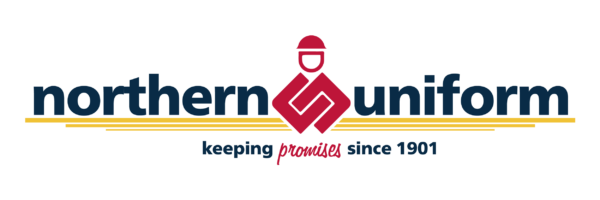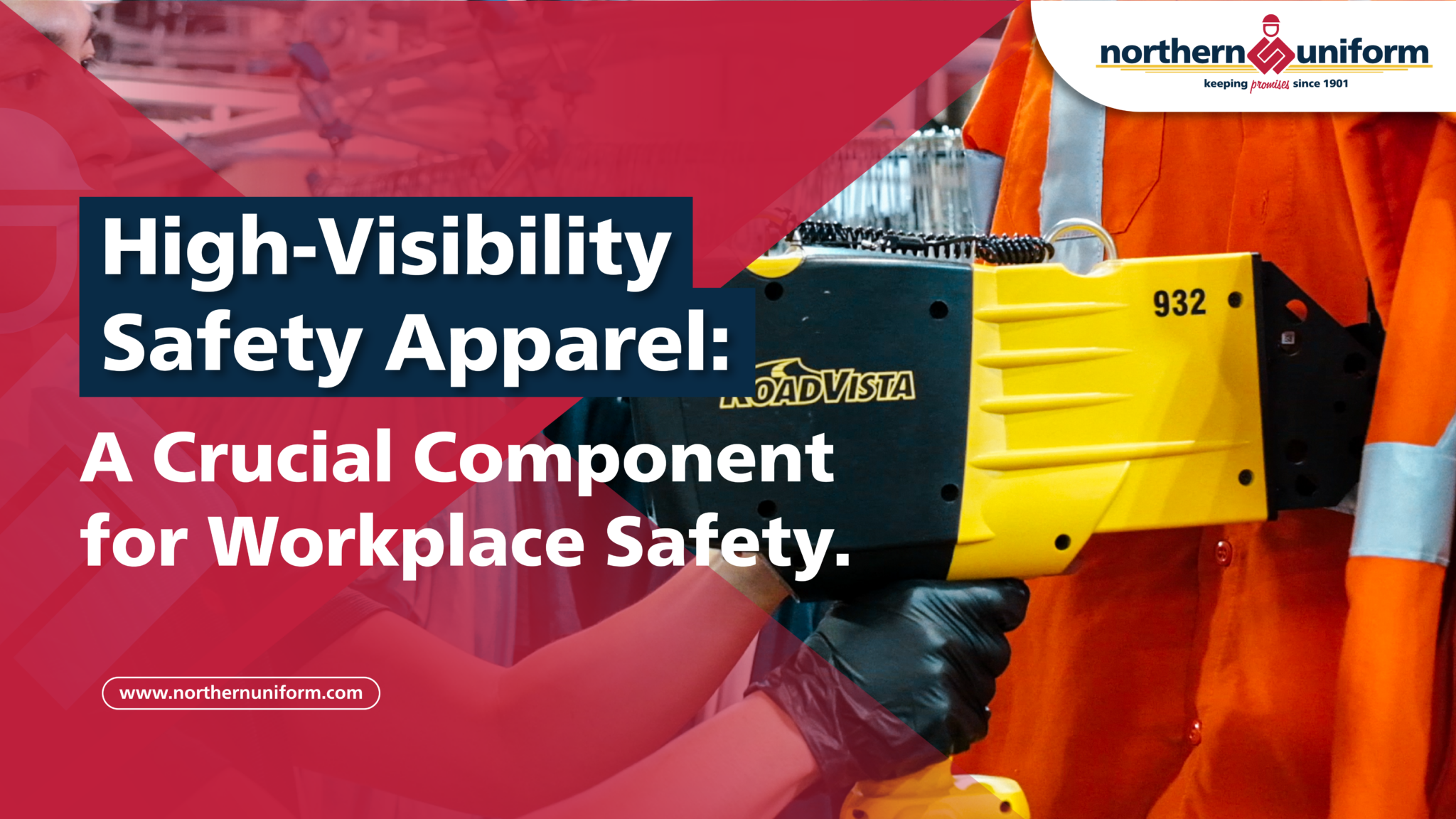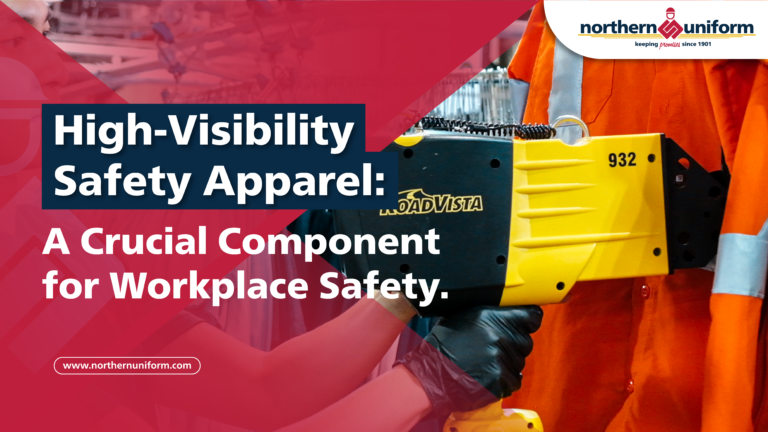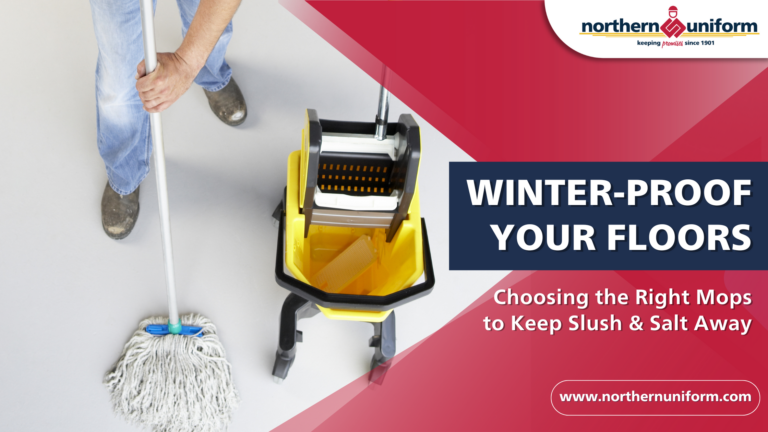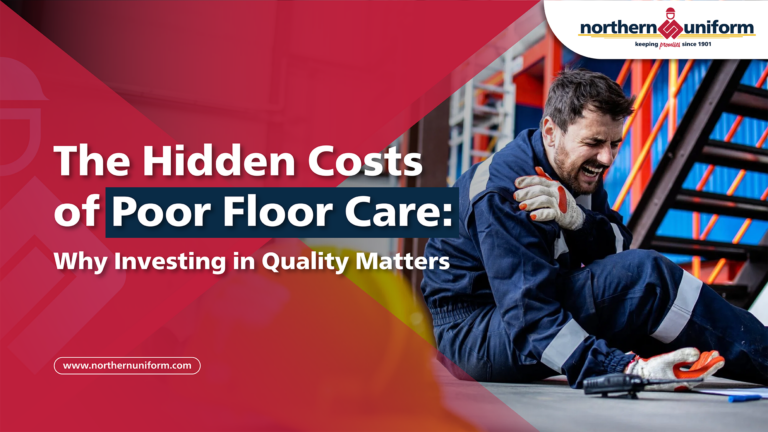In various industries where workers are exposed to moving vehicles or machinery, the importance of being seen cannot be overstated. High-Visibility Safety Apparel (HVSA) is an essential component of Personal Protective Equipment (PPE) designed to improve worker visibility, particularly in low-light conditions. For Northern Uniform, which supplies high-visibility workwear across diverse sectors, understanding the significance, standards, and application of HVSA is crucial to ensuring the safety of its customers and their workers.
What is High-Visibility Safety Apparel?
High-Visibility Safety Apparel refers to clothing that enhances a worker’s visibility in environments where there is a risk of being struck by moving vehicles, machinery, or other hazards. HVSA typically includes vests, coveralls, jackets, bibs, and headwear that feature fluorescent and retroreflective materials. The primary goal is to make the wearer stand out against their background, ensuring they can be easily seen, especially in conditions where lighting is poor or visibility is compromised.
Key Characteristics of HVSA:
- Fluorescent Materials: These materials convert invisible UV light into visible light, making the clothing appear bright under natural light, even in overcast or low-light situations.
- Retroreflective Materials: These materials reflect light directly back to its source, making the wearer more visible to drivers and equipment operators in low-light conditions, such as nighttime or when artificial lighting is in use.
- Combined-Performance Materials: Some HVSA uses materials that are both fluorescent and retroreflective, offering maximum visibility during both daytime and nighttime operations.
Why is High-Visibility Safety Apparel Important?
The primary function of HVSA is to prevent accidents by making workers more visible to drivers and equipment operators. Visibility is especially critical in situations where workers are near moving vehicles or machinery, particularly in industries such as construction, road work, mining, warehousing, and logistics.
Key Benefits of HVSA:
- Enhanced Worker Safety: HVSA significantly reduces the risk of accidents by increasing the distance from which a worker can be seen. This allows drivers and equipment operators more time to react appropriately.
- Compliance with Safety Standards: Many industries require the use of HVSA under national safety regulations, such as Canada’s CSA Z96-15 Standard for High-Visibility Safety Apparel, or the ANSI/ISEA 107-2015 Standard in the U.S. Adhering to these standards is essential for legal compliance and worker safety.
- Improved Visibility in Various Conditions: HVSA is designed to provide high visibility under a variety of conditions—whether it’s the bright sun, dusk, dawn, fog, rain, or nighttime. This ensures that workers are always visible, regardless of environmental conditions.
HVSA and Risk Assessment
Before selecting HVSA, it’s important for employers to conduct a hazard assessment of the job site. This evaluation identifies potential risks and helps determine the level of visibility required for workers. Factors that should be considered during the hazard assessment include:
- Type of work: Does the job involve interaction with vehicles or mobile equipment?
- Work environment: Is the area urban or rural? Is the background cluttered, such as on a construction site, or simple and uniform, like in a warehouse?
- Lighting conditions: Is the work being conducted indoors or outdoors? Will the light conditions change throughout the day?
- Traffic: How fast and heavy is the traffic in the area? Are vehicles or machinery traveling at high speeds?
Once the hazard assessment is complete, the appropriate class of HVSA can be selected.
The Different Classes of High-Visibility Safety Apparel
The CSA Z96-15 (R2020) Standard for High-Visibility Safety Apparel categorizes HVSA into three classes based on the level of body coverage and visibility provided. These classes help employers select the right type of apparel based on the risk level and specific needs of the job. Let’s take a look at this infographic to have a better understanding of CSA Z96-15 Standard.
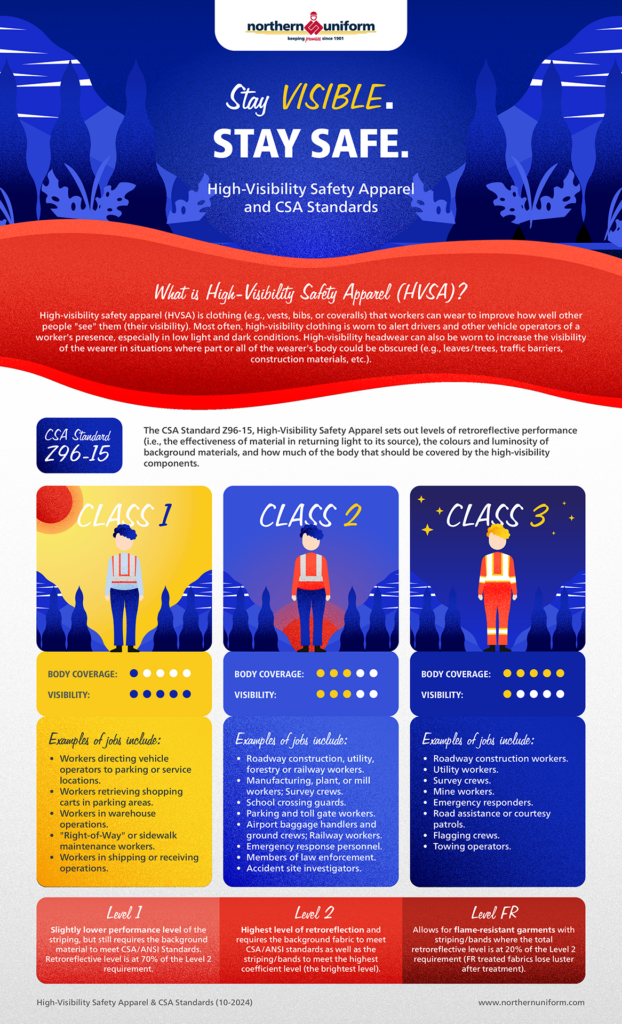
Now, let’s go into details and examples for each classes.
Class 1: Low Coverage, Basic Visibility
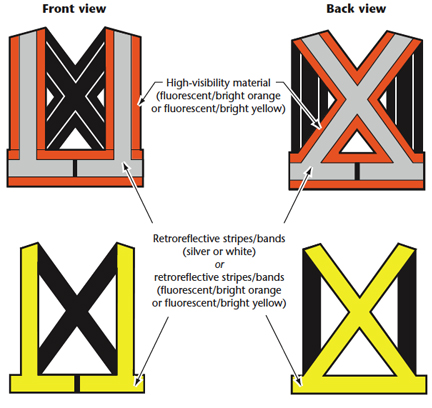
*NOTE: Other options are possible, including a shirt made of non-high-visibility material, but with high-visibility or retroreflective stripes/bands.
Class 1 apparel offers the least amount of visibility and is typically used in low-risk environments where there is minimal exposure to moving vehicles or machinery. Workers in Class 1 apparel are often performing tasks that allow them to remain fully aware of their surroundings. Examples include:
- Workers directing vehicle operators to parking or service locations.
- Workers retrieving shopping carts in parking areas.
- Workers in warehouse operations.
- “Right-of-Way” or sidewalk maintenance workers.
- Workers in shipping or receiving operations.
Class 2: Moderate Coverage, Enhanced Visibility
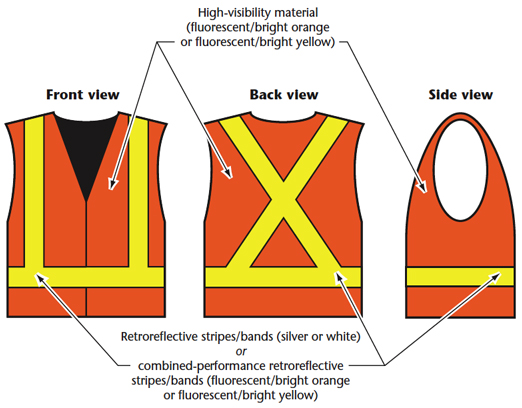
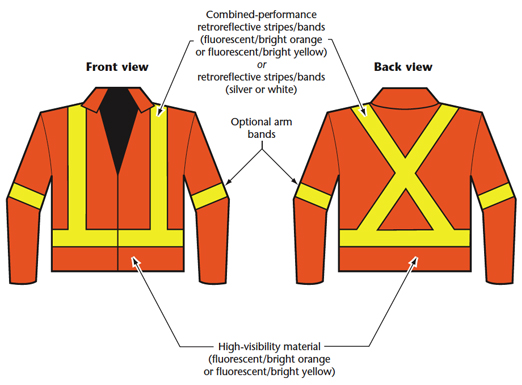
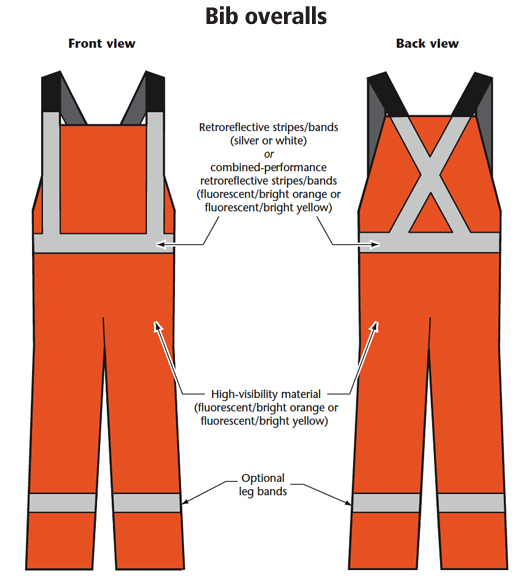
*NOTE: These examples are not the only options available and are shown for example purposes.
Class 2 apparel provides more body coverage than Class 1 and is suitable for environments where vehicles or equipment are moving at moderate speeds. Workers in these environments need more visibility due to the complexity of the background or potential distractions. Class 2 apparel is often used by:
- Roadway construction, utility, forestry or railway workers.
- Manufacturing, plant, or mill workers.
- Survey crews.
- School crossing guards.
- Parking and toll gate workers.
- Airport baggage handlers and ground crews.
- Emergency response personnel.
- Members of law enforcement.
- Accident site investigators.
- Railway workers.
Class 3: Full Coverage, Maximum Visibility
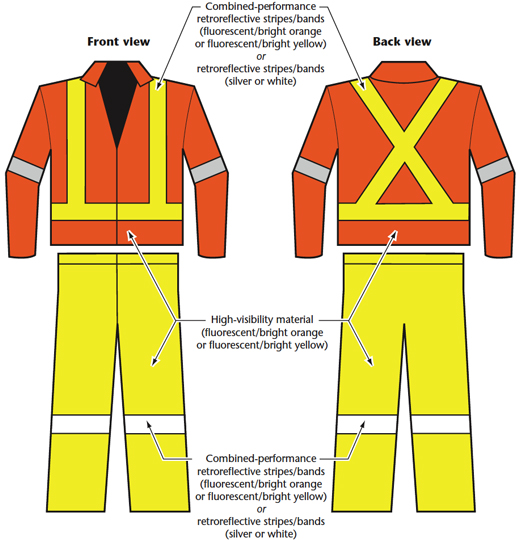
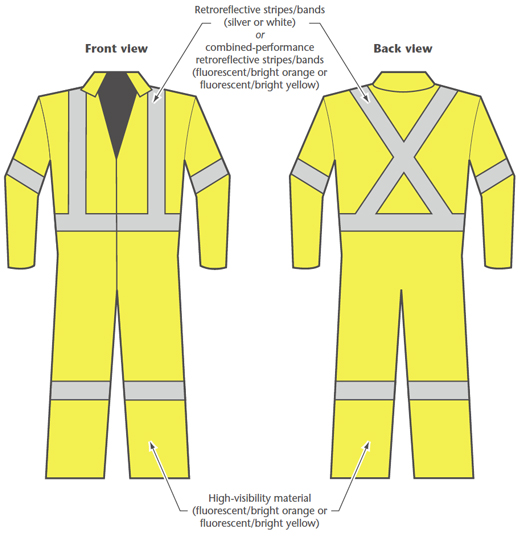
NOTE: These examples are not the only options available and are shown for example purposes.
Class 3 apparel provides the highest level of visibility, covering most of the body, including the arms and legs. This class suits high-risk environments where workers face fast-moving traffic or work in low-light or adverse weather conditions. Workers in Class 3 apparel typically perform tasks that may divert their attention from oncoming hazards. Examples include:
- Roadway construction workers.
- Utility workers.
- Survey crews.
- Mine workers.
- Emergency responders.
- Road assistance or courtesy patrols.
- Flagging crews.
- Towing operators.
Key Considerations When Choosing HVSA
1. Coverage and Fit
Proper coverage ensures that the wearer is visible from all angles (360° visibility). Garments that provide full coverage, such as coveralls with reflective stripes on the arms and legs, are ideal for maximum visibility. Proper fit is equally important, as ill-fitting garments can obscure visibility or cause discomfort, leading to potential safety hazards.
2. Comfort and Durability
Since HVSA is often worn for extended periods, the comfort of the garment is critical. Breathable, lightweight materials are preferred for comfort, especially in warmer climates. Additionally, the durability of HVSA is important as the garments must withstand frequent wear and tear, particularly in rugged environments like construction or mining.
3. Environmental Factors
The type of environment where the work is conducted plays a significant role in determining the type of HVSA required. For example:
- In bright daylight conditions, fluorescent materials are highly effective.
- In low-light or nighttime conditions, retroreflective materials are more beneficial.
- In environments exposed to fire or extreme heat, flame-resistant HVSA is necessary.
4. Customization
Many companies choose to add logos or name tags to their HVSA for branding purposes. However, it’s important to ensure that these additions do not interfere with the garment’s visibility or the placement of reflective materials. According to the CSA Standard, a non-reflective identification badge should be small and positioned so it does not obscure critical reflective stripes.
Maintenance and Care of High-Visibility Safety Apparel
To ensure the continued effectiveness of HVSA, it’s important to maintain the garments properly. Over time, dirt, grime, and wear can reduce the visibility of the reflective materials, compromising safety. Therefore, regular cleaning and inspection are essential. Employers should replace HVSA that shows signs of wear, such as:
- Faded colors
- Damaged or missing reflective strips
- Rips or tears in the fabric
Additionally, Northern Uniform ensures that all high-visibility garments meet the standards for safety and durability, providing our clients with high-quality products that withstand the demands of their work environment. A tangible benefit of our commitment to the standard is our reflectivity audit of uniforms to ensure they meet the CSA underground Class 3 Level 2 standard.

About Northern Uniform Service
Northern Uniform Service is proudly based in Sudbury, extending our top-quality services across Northern Ontario to the Greater Toronto Area, and from Timmins to Hamilton, and Sault Ste. Marie, North Bay to Timmins. We operate a depot in Bradford, ON, and have recently opened a new depot in Timmins, ON, to better serve our expanding customer base.
We specialize in providing uniform rental, towel and mat rental, and other facility services to a diverse range of industries, including mining, food processing, construction, and manufacturing.
Since 1901, the Bisset family has been dedicated to serving the retail and commercial laundry market in Ontario. In 1972, James Robert (JR) Bisset recognized the growing need for specialized uniform and mat rental services and incorporated Northern Uniform.
Today, Northern Uniform Service is one of the only companies in North America to achieve both ISO 22000:2018 and ISO 9001:2015 registrations, underscoring our commitment to quality and safety standards.
Don’t leave your team’s safety and comfort to chance. Contact us today to get started on your personalized consultation and quote on high-quality, durable work outerwear solutions tailored to your business needs.
Conclusion
High-Visibility Safety Apparel plays a vital role in maintaining the safety of workers in various industries. By ensuring that workers are visible to drivers, equipment operators, and other workers, HVSA helps prevent accidents and fatalities. Northern Uniform commits to supplying high-visibility garments that meet the highest safety standards, including CSA Z96-15 and ANSI/ISEA 107, ensuring that workers remain safe, comfortable, and visible in all conditions.
At Northern Uniform, we understand that choosing the right HVSA can be overwhelming, especially with the variety of options available. That’s why we offer personalized consultation services to help you select the appropriate high-visibility garments based on your industry’s specific needs, risk factors, and compliance requirements. Whether you’re in construction, mining, logistics, or roadwork, our high-visibility workwear provides the protection and visibility your workers need to stay safe on the job.
Stay safe. Stay seen. Choose Northern Uniform for your high-visibility safety apparel needs.
